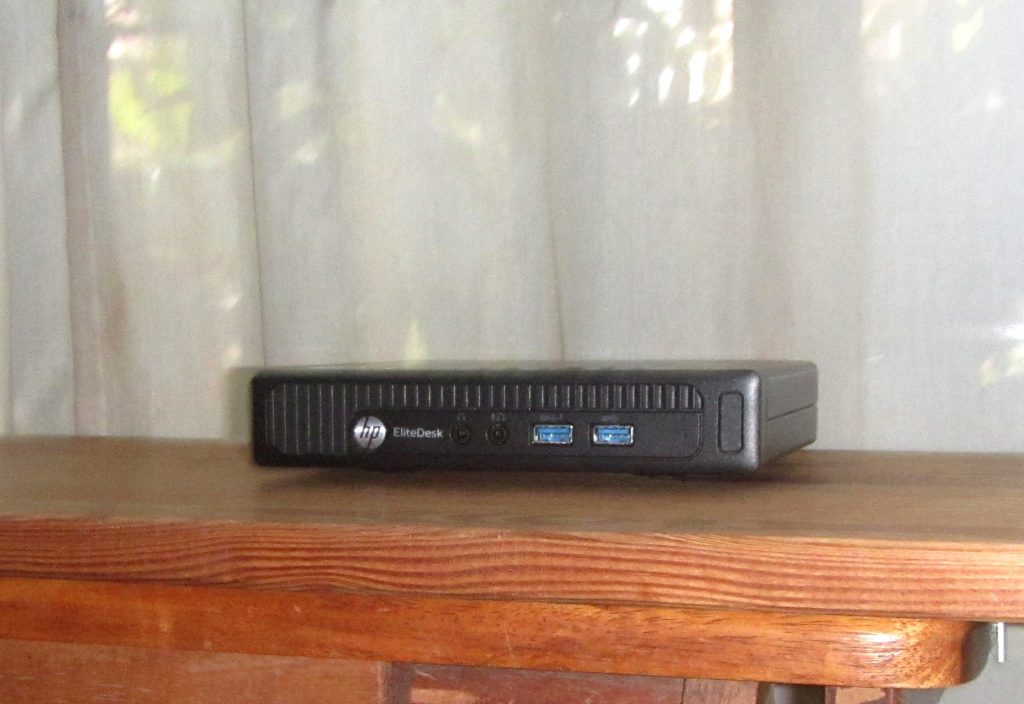
One of most popular business class is the HP Elitedesk 800 G1 Mini as shown above. This PC uses the Intel 4th generation CPUs which are removable in the LGA1150 socket. Although the Intel 4th generation CPUs came out as long ago as 2014, these processors are still considered relatively fast enough for average use. Hence with a solid state drive, the HP Elitedesk 800 G1 Mini using, say, an i5-4590t processor, can still deliver respectable performances running Windows 10 Professional for those Working From Home (WFH) or using it for Home Based Learning (HBL).
The Intel 4th generation CPUs can range from Pentium like G3250t or Celeron such as G1820t or G1840t, to i3s like the i3-4130t or i3-4150t and i3-4160t. At the higher end is the i5-4570t and the i5-4590t. The i5-4590t is a step ahead as it is a quad core CPU whereas anything below it is at best 2 Core. Above that is the i7-4565t and the top of the line i7-4785t for mini desktops. The performance of the i7-4785t can be considered as not bad even in comparison with newer CPUs up to perhaps i5 for mini desktops.
The Intel 4th generation CPUs mentioned earlier are not exhausive and there are many additional CPUs at the Pentium, Celeron, i3 and i5 levels. However the important thing to note is that the Mini desktops use the 35W CPU version with the suffix t at the end. The Mini desktops themselves are powered by a 65W power adapter. Thus this 65W power adapter not only must drive the CPU but also the motherboard, RAM and SSD or HDD plus any USB devices in which you plug in.
Other versions of the Intel 4th generation CPUs like the i5-4590S, or i3-4330 cannot be used in these mini desktops. The i5-4590S is rated at 65W whereas the i3-4330 is at 54W. These other CPUs are meant for other larger HP desktops like the Ultra Slim Desktop (USDT) or Small Form Factor (SFF) or Tower PCs.
The HP Elitedesk 800 G1 Mini Desktop PC is the top of the line model for this manufacturer for the Intel 4th generation CPUs. Although this model can accept the M.2 SATA SSD, the PC cannot boot from this device, only from the 2.5in SSD. Other versions of the Mini Desktop PC include the HP Prodesk 400 G1 Mini and the HP Prodesk 600 G1 Mini. Specs of the HP Prodesk 600 G1 Mini are fairly close to that of the premium HP Elitedesk 800 G1 Mini Desktop PC except that there is no M.2 SATA SSD slot. The HP Prodesk 400 Mini is the most basic for desktop PCs in this range.
Besides HP, Lenovo also has a range of desktop PCs using the Intel 4th generation CPUs. Lenovo’s business class range includes the M93p Tiny, the M83 Tiny and the M73 Tiny. The M93p is the premium version with 2 front and 3 rear USB3.0 ports. The rare M83 Tiny has 2 front and 2 rear USB3.0 port and a rear USB2.0 port. The more common M73 Tiny is the basic version with 2 front USB3.0 and 3 rear USB2.0 ports.
In addition to HP and Lenovo, Dell has 2 desktop PC versions of its business class PCs. The Dell 9020 micro is the premium version which not only has a slot for M.2 SATA SSD but can also boot from it. In addition, there is a slot for a 2.5in SSD or HDD using the easy to remove and fit Dell caddy. Therefore with this Dell, you can have a smaller SSD, say 128GB or 240GB, running Windows 10 Professional on the M.2 SATA SSD and a 5ooGB HDD for your data. At the basic level is the Dell 3020 micro, comparable to the Lenovo M73 Tiny and the HP Prodesk 400 G1 Mini.
There are few if any significant differences between the HP, Lenovo and Dell other than the latter’s ability to install and boot from the M.2 SATA SSD. All of them come with 65W power adapters. Most of these business class PCs would originally be running Windows 7 Professional which one can easily upgrade to Windows 10 Professional. As for which one to purchase, the choice is yours.
This writeup is by beetlek who offers a wide range of mostly used small desktop PCs and occasional laptops for sale in Carousell Singapore. You can see his offering at this link https://www.carousell.sg/u/beetlek/ or search for user beetlek at Carousell Singapore.
